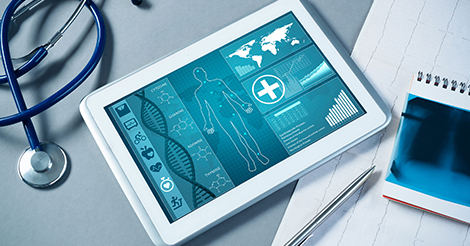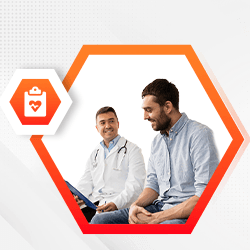Body Screening Tests & Checkup
Laboratory Work +−
Blood and urine tests in the laboratory detect any disturbances in the chemical levels of your body. There are several tests done, each for its specific purpose:
- Haemogram: For detailed assessment of vital parameters of blood
- Blood Group: Essential for donating or receiving blood in case of emergencies
- Urine test (Routine & Micro): For detecting infections or any other abnormality in the kidneys and urinary tract
- Blood sugar For detecting blood sugar levels. Essential in detecting diabetes
- Blood Urea & Serum Creatinine: For assessing the performance of the kidneys
- SGPT, SGOT, Serum Bilirubin: For assessing the performance of the liver
- Lipid profile: For analysis of the good and bad cholesterol levels in your blood as they are an excellent indicator of the condition of your heart
- Thyroid Stimulating Hormone (TSH): For assessing the functioning of thyroid gland
- Australia Antigen: For detecting the presence of Hepatitis B
- Vitamin B 12: For assessing the levels as it plays a key role in the normal functioning of the brain, nervous system and in the formation of blood
How it is done?
You will be made to sit on a chair with your arm on the hand-rest of the chair or on a table. The technician will insert the needle in a particular vein of your arm and draw in a small quantity of blood, which will then be sent to a lab.
Chest X-Ray+−
A simple and quick procedure that scans the lungs and heart for diseases or irregularities.
How it is done?
The technician will position you correctly on the x-ray table. You should not wear any jewellery or metal objects. The technician may ask you to hold your breath for few seconds. Women who suspect pregnancy or are pregnant should not undertake this test. Pregnant ladies should not enter the X-Ray room.
Electro Cardiogram (ECG)+−
An ECG maps the electrical activity and muscular functioning of the heart. It also indicates other abnormal conditions of heart.
How it is done?
You will be asked to lie down on a bed/table. Electrodes (small clip-like objects) will be attached to your arms, legs and chest and a gel is applied. A reading of the ECG will be taken from a monitor attached to the electrodes. You have to lie very still and breathe normally unless instructed to hold it. You should not talk during the test.
2D Echo Cardiography (Colour Doppler of heart)+−
It is a kind of ultrasound which provides detailed analysis of the heart on various parameters such as valves, heart chambers, cardiac capacity, congenital defects, etc.
How it is done?
A colourless gel is applied to the chest or on the transducer head. You will be asked to lay on your left side as the technician moves the transducer across the different parts of your chest to get specific views of the heart.
Sono-mammography+−
A type of ultrasound conducted to detect and diagnose any lumps in the breasts to screen out cancerous probabilities.
How it is done?
A Gel will be put on the breast so the transducer can pick up the sound waves as it is moved back and forth over the breast. A picture of the breast tissue can be seen on a TV screen.
Ultrasonography of abdomen & pelvis +−
This helps to determine any abnormality in the abdominal organs and detect stones and inflammation of the liver, gall bladder, spleen, pancreas and kidneys.
How it is done?
A gel will be applied on the whole abdominal area and the transducer is moved slowly over it. An image of the abdominal area will appear on the attached monitor.
You will be required to have your urinary bladder full by drinking lots of water.
Total body fat percentage+−
This gives you the percentage of fat present in your body in proportion with muscles. This is helpful in determining one’s obesity level.
Pap smear+−
Critical in detection of cervical cancer (which is completely curable if detected at an early stage). It is very common in females.
How it is done?
You will need to lie down on your back. A speculum is then inserted into the vaginal area and a small cervical brush is inserted into the openings of the cervix and twirled around to collect a sample of the cells. The results of the Pap smear are usually available after 4/5 days. Women should ideally have Pap smear in the mid of their cycle and not close to having or during their periods.
Transvaginal Ultrasound (TVS)+−
TVS is done to obtain complete evaluation of the pelvic area more appropriately in females.
How it is done?
For TVS you will need to lie down on your back with your feet in stirrups. A transducer is inserted into the vagina after the patient empties her bladder. A protective cover is placed over the transducer and lubricated with a small amount of gel to avoid any discomfort.
Pulmonary Lung Function+−
Breathing exercises that check lung condition and lung capacity, which can get altered in some lung and heart conditions.
How it is done?
You will need to wear loose fitting clothes that do not restrict your breathing. If you wear dentures, you will have to remove them. A mouth piece will be inserted in your mouth and you will be asked to breathe in, hold your breath and breathe out several times.
Screening Audiometry Test+−
Loss of hearing is a gradual process and sometimes goes unnoticed to the patient. Early detection of this defect can help in taking corrective measures.
How it is done?
You will be asked to wear special headphones. The technician will instruct you to raise your hand every time you hear a tone through these headphones. A headband with a small plastic rectangle that fits behind your ear will be put. The tones will be repeated.
Stress Test or Treadmill Test+−
This test is done to check the possibility of blockages in the heart’s blood vessels, when the person is put to exercise.
How it is done?
You are connected to the ECG machine with electrodes and told to walk on the treadmill (a machine commonly seen in gyms and fitness centres). The speed and elevation of the treadmill is increased gradually. You should wear comfortable footwear on the treadmill. In case of any discomfort during the test, inform the technician immediately.
Ophthalmology+−
A routine eye check-up to check vision and condition of the eyes.
How it is done?
You will be made to sit on a special chair and after a preliminary examination of the eyes, you will be asked to read some text. In some cases eye drops may be put in your eyes for a more detailed examination by other instruments.
Bone Mineral Densitometry (BMD)+−
Helps in assessing bone loss, which can lead to osteoporosis, the main reason for fragile bones that fracture easily.
How it is done?
Since it is a type of x-ray, BMD is done in the radiology department. You will need to lie down on your back on a table and the machine will scan your bones of hip and lower spine.
CT Coronary Angiography (Heart)+−
This test is non-invasive and very precisely detects any blockages in the blood vessel.
CT Screening of Neck Vessels (Carotid)+−
This evaluates the condition of blood vessels in the neck. By early detection, any narrowing of vessels can be treated to prevent complications in the future.
CT Screening of Intracranial Vessels (Brain)+−
Detects narrowing, blockages and growths in vessels to the brain. This test is critical to prevent fatal conditions like brain haemorrhage.
CT Brain (Contrast)+−
This test gives us information about any pathology in the brain tissues like tumours, haemorrhage etc. It is a quick process that takes only about 3 seconds.
CT Calcium Scoring+−
A non-invasive procedure to obtain information about the presence, location and extent of calcified plaque in the coronary arteries due to a build-up of fat or other substances.
How these are done?
For all the above CT tests, the procedure remains same. You will be asked to lie down on your back on the CT scanning table. A contrast medium is injected (except in CT calcium scoring) intravenously. Your heart rate is continuously monitored during the procedure with the help of ECG leads. You are asked to hold breath for 15-20 sec during the scan.
You should not eat or drink anything except water for at least 2 hours prior to the test. This test will not be done in case of pregnancy or suspected pregnancy
CT Scanogram / X-Ray of Lumbar Spine and Cervical Spine+−
This evaluates the condition of the lumbar and cervical spine. This test is essential in proper diagnosis and treatment of chronic lower back pain.
Gynaecology Consultation+−
A detailed consultation for women regarding contraception, conception, pregnancy and self-testing for presence of certain diseases.
Fitness Consultation+−
A fitness expert advises you on the proper fitness program to follow taking into consideration factors like your age, weight, medical history etc.
Diet Consultation: Consultation with a dietician to guide you for balanced diet and proper eating habits. Dietician will also suggest changes in diet, if any required. This consultation will give you in-depth understanding of how to eat better and stay healthy.
Expert Counselling by Doctor+−
A final assessment of all your test reports by an experienced doctor. The doctor will give you a detailed analysis of your test results and suggest corrective measures as needed. It is advisable to keep a proper follow-up with your family doctor regarding any measures that are suggested.

Body Screening Tests & Checkup
Blood and urine tests in the laboratory detect any disturbances in the chemical levels of your body. There are several tests done, each for its specific purpose:
- Haemogram: For detailed assessment of vital parameters of blood
- Blood Group: Essential for donating or receiving blood in case of emergencies
- Urine test (Routine & Micro): For detecting infections or any other abnormality in the kidneys and urinary tract
- Blood sugar For detecting blood sugar levels. Essential in detecting diabetes
- Blood Urea & Serum Creatinine: For assessing the performance of the kidneys
- SGPT, SGOT, Serum Bilirubin: For assessing the performance of the liver
- Lipid profile: For analysis of the good and bad cholesterol levels in your blood as they are an excellent indicator of the condition of your heart
- Thyroid Stimulating Hormone (TSH): For assessing the functioning of thyroid gland
- Australia Antigen: For detecting the presence of Hepatitis B
- Vitamin B 12: For assessing the levels as it plays a key role in the normal functioning of the brain, nervous system and in the formation of blood
How it is done?
You will be made to sit on a chair with your arm on the hand-rest of the chair or on a table. The technician will insert the needle in a particular vein of your arm and draw in a small quantity of blood, which will then be sent to a lab.
A simple and quick procedure that scans the lungs and heart for diseases or irregularities.
How it is done?
The technician will position you correctly on the x-ray table. You should not wear any jewellery or metal objects. The technician may ask you to hold your breath for few seconds. Women who suspect pregnancy or are pregnant should not undertake this test. Pregnant ladies should not enter the X-Ray room.
An ECG maps the electrical activity and muscular functioning of the heart. It also indicates other abnormal conditions of heart.
How it is done?
You will be asked to lie down on a bed/table. Electrodes (small clip-like objects) will be attached to your arms, legs and chest and a gel is applied. A reading of the ECG will be taken from a monitor attached to the electrodes. You have to lie very still and breathe normally unless instructed to hold it. You should not talk during the test.
It is a kind of ultrasound which provides detailed analysis of the heart on various parameters such as valves, heart chambers, cardiac capacity, congenital defects, etc.
How it is done?
A colourless gel is applied to the chest or on the transducer head. You will be asked to lay on your left side as the technician moves the transducer across the different parts of your chest to get specific views of the heart.
A type of ultrasound conducted to detect and diagnose any lumps in the breasts to screen out cancerous probabilities.
How it is done?
A Gel will be put on the breast so the transducer can pick up the sound waves as it is moved back and forth over the breast. A picture of the breast tissue can be seen on a TV screen.
This helps to determine any abnormality in the abdominal organs and detect stones and inflammation of the liver, gall bladder, spleen, pancreas and kidneys.
How it is done?
A gel will be applied on the whole abdominal area and the transducer is moved slowly over it. An image of the abdominal area will appear on the attached monitor.
You will be required to have your urinary bladder full by drinking lots of water.
This gives you the percentage of fat present in your body in proportion with muscles. This is helpful in determining one’s obesity level.
Critical in detection of cervical cancer (which is completely curable if detected at an early stage). It is very common in females.
How it is done?
You will need to lie down on your back. A speculum is then inserted into the vaginal area and a small cervical brush is inserted into the openings of the cervix and twirled around to collect a sample of the cells. The results of the Pap smear are usually available after 4/5 days. Women should ideally have Pap smear in the mid of their cycle and not close to having or during their periods.
TVS is done to obtain complete evaluation of the pelvic area more appropriately in females.
How it is done?
For TVS you will need to lie down on your back with your feet in stirrups. A transducer is inserted into the vagina after the patient empties her bladder. A protective cover is placed over the transducer and lubricated with a small amount of gel to avoid any discomfort.
Breathing exercises that check lung condition and lung capacity, which can get altered in some lung and heart conditions.
How it is done?
You will need to wear loose fitting clothes that do not restrict your breathing. If you wear dentures, you will have to remove them. A mouth piece will be inserted in your mouth and you will be asked to breathe in, hold your breath and breathe out several times.
Loss of hearing is a gradual process and sometimes goes unnoticed to the patient. Early detection of this defect can help in taking corrective measures.
How it is done?
You will be asked to wear special headphones. The technician will instruct you to raise your hand every time you hear a tone through these headphones. A headband with a small plastic rectangle that fits behind your ear will be put. The tones will be repeated.
This test is done to check the possibility of blockages in the heart’s blood vessels, when the person is put to exercise.
How it is done?
You are connected to the ECG machine with electrodes and told to walk on the treadmill (a machine commonly seen in gyms and fitness centres). The speed and elevation of the treadmill is increased gradually. You should wear comfortable footwear on the treadmill. In case of any discomfort during the test, inform the technician immediately.
A routine eye check-up to check vision and condition of the eyes.
How it is done?
You will be made to sit on a special chair and after a preliminary examination of the eyes, you will be asked to read some text. In some cases eye drops may be put in your eyes for a more detailed examination by other instruments.
Helps in assessing bone loss, which can lead to osteoporosis, the main reason for fragile bones that fracture easily.
How it is done?
Since it is a type of x-ray, BMD is done in the radiology department. You will need to lie down on your back on a table and the machine will scan your bones of hip and lower spine.
This test is non-invasive and very precisely detects any blockages in the blood vessel.
This evaluates the condition of blood vessels in the neck. By early detection, any narrowing of vessels can be treated to prevent complications in the future.
Detects narrowing, blockages and growths in vessels to the brain. This test is critical to prevent fatal conditions like brain haemorrhage.
This test gives us information about any pathology in the brain tissues like tumours, haemorrhage etc. It is a quick process that takes only about 3 seconds.
A non-invasive procedure to obtain information about the presence, location and extent of calcified plaque in the coronary arteries due to a build-up of fat or other substances.
How these are done?
For all the above CT tests, the procedure remains same. You will be asked to lie down on your back on the CT scanning table. A contrast medium is injected (except in CT calcium scoring) intravenously. Your heart rate is continuously monitored during the procedure with the help of ECG leads. You are asked to hold breath for 15-20 sec during the scan.
You should not eat or drink anything except water for at least 2 hours prior to the test. This test will not be done in case of pregnancy or suspected pregnancy
This evaluates the condition of the lumbar and cervical spine. This test is essential in proper diagnosis and treatment of chronic lower back pain.
A detailed consultation for women regarding contraception, conception, pregnancy and self-testing for presence of certain diseases.
A fitness expert advises you on the proper fitness program to follow taking into consideration factors like your age, weight, medical history etc.
Diet Consultation: Consultation with a dietician to guide you for balanced diet and proper eating habits. Dietician will also suggest changes in diet, if any required. This consultation will give you in-depth understanding of how to eat better and stay healthy.
A final assessment of all your test reports by an experienced doctor. The doctor will give you a detailed analysis of your test results and suggest corrective measures as needed. It is advisable to keep a proper follow-up with your family doctor regarding any measures that are suggested.
Are you looking to modify your lifestyle and habits to improve the quality of your life? Answer simple questions related to your Immunity, Fitness, Nutrition, Health and Habits check your health assessment. View More






